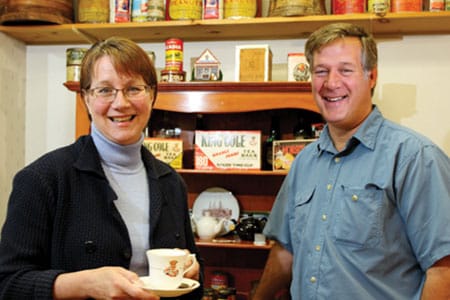As old as Canada itself, G.E. Barbour is still going strong (just like its popular King Cole cuppa), but not without a few changes.
When Charles Darwin stepped ashore on the Galapagos Islands in 1835, he found himself surrounded at every turn by flora and fauna unlike any he had ever seen, none more so than the resident colony of iguana lizards. The iguana is typically a land-based vegetarian, climbing trees to get at tender branches—everywhere, that is, except on Galapagos. There, the iguana were mostly seen swimming underwater, grazing on seabed vegetation.
As old as Canada itself, G.E. Barbour is still going strong (just like its popular King Cole cuppa), but not without a few changes.
When Charles Darwin stepped ashore on the Galapagos Islands in 1835, he found himself surrounded at every turn by flora and fauna unlike any he had ever seen, none more so than the resident colony of iguana lizards. The iguana is typically a land-based vegetarian, climbing trees to get at tender branches—everywhere, that is, except on Galapagos. There, the iguana were mostly seen swimming underwater, grazing on seabed vegetation.
The Galapagos iguana had adapted to a watery environment to survive extirpation through a lack of food on land, and thereby became the genesis of Mr. Darwin’s theories of adaptation and evolution.

The example is no less true in business, where adaptation to external change is the essential mantra for survival in a global economy.
Which takes us to the incongruous existence of G.E. Barbour & Co. of Sussex, NB, a family-owned business as old as Canada itself. It’s a company that prospers not by capitalizing on natural resources, but by importing everything it needs to make the products it manufactures, then sending them back to the global marketplace.
“We bring the peanuts in from Georgia, roast them, smash them up, and send the peanut butter to Texas,” says marketing vice-president Robert MacLeod, referring to one of Barbour’s biggest private-label customers, a supermarket chain. They do the same for a major retail chain in Quebec, and this past May sent their first private label order to Saudi Arabia.
Indeed, about 35 per cent of the manufacturing activity at G.E. Barbour carries somebody else’s brand name.
What you do see when grocery shopping regionally is Barbour’s Original Peanut Butter and King Cole Tea, the latter celebrating 100 years of existence this year, and still a favourite brand when Maritimers want a cuppa.
It all comes down to quality, says company CEO Grant Brenan, a disarmingly unpretentious boss who prides himself on knowing every employee—there are 85—by his or her first name, regularly touring the production floor to stay in contact with employees.
He, along with sister Sylvia MacVey, vice-president in charge of production, and brother Fred, vice-president of export sales (who all now own the company) employ an old-fashioned approach to human relations, at the core of enlightened management: treat your employees with respect; they’ll respond with loyalty to the company, and pride in the quality of the products they produce.
There is a miniscule turnover in workers at G.E. Barbour. As Grant Brenan puts it: “I’ve given out an awful lot of 25-year plaques.”
He started in the family business working summers at the age of 15. In 1987, at age 27, he was thrust into the CEO’s seat when his father was hurt in a car accident, spending five years in a coma before passing.
Back then much of Barbour’s business was with small, independently owned grocery stores throughout the region. Then came the 60s, and with that decade the rise of the supermarket owned by huge retail chains, displacing some of the small independents.
For G.E. Barbour, everything changed—its customer base was shifting. There was nothing the company could do about it… except adapt.
G.E. Barbour began as a wholesale grocery business in Saint John. Grant Brenan’s grandfather was an employee. He purchased the company from the Barbour family in the early 50s. By that time it had evolved into food production—mostly making peanut butter and blending tea, as well as other nut butters, spices and extracts, cheese, baking powder and popcorn seasonings.
In the late 60s, G.E. Barbour moved the company to Sussex, mainly to be near the Trans-Canada Highway for easy distribution of products.
“The environment around us is always changing,” says Grant. “The one thing we have never changed is the quality of what we produce. Our peanut butter is the freshest. Our tea has a very high quality.”
Chain stores have a different way of doing business. Brand names must compete for shelf space. Price collides with quality.
“We believe people will pay a little more for quality… People may leave you for awhile, but quality always brings them back.“
Nowhere is the Barbour obsession with quality more evident than in the presence and persona of a genial Irish emigrant named Des McCarthy. He arrived in Sussex from Dublin in 1985, with his wife and son, to take up his position as “the tea guy.”
The blending of different tea from around the world—Kenya, Sri Lanka and India, for example—into a consistent flavour is an art, whether the tea is a traditional blend, or one of the new organic herbal or decaffeinated green teas the company now produces.
“There is no college degree in tea-ology,” says Des with a smile. “There aren’t very many of us around.”
His educated, sensitive taste buds are able to detect infinitesimal nuances in the body of individual teas. His job is to blend those nuances together in precise proportions; to consistently deliver the taste and flavour that King Cole tea imbibers have come to expect.
Given the variables of growing tea around the world, Des McCarthy’s job is anything but routine. Tea leaves grown on opposite sides of a hill in northern India will have differing properties. He must identify the differences, and account for them in his blending techniques.
Hard-core tea drinkers can be demanding, and Atlantic Canada has a lot of them—more, proportionately, than anywhere else in Canada. Hence it’s not a stretch to say that the fortunes of King Cole Tea, and the brand’s leading market share in the Atlantic Provinces, are dependent on the sensitivity of Desmond McCarthy’s taste buds to deliver a consistent flavour in a tiny tea bag.
However, time can erode even the most innocuous symbols of quality—in this case, the gauze tea bag that encloses a single serving of King Cole tea. Which brings us to the latest adaptation the company must make: the radical change from the familiar and trusted gauze bag, to paper.
King Cole Tea is making the changeover in this 100th anniversary year not because it wants to, but because the company simply can no longer get the gauze it needs to make its tea bags. It has taken great pains to ensure King Cole devotees that the consistent taste will endure.
So, it seems, will G.E. Barbour. A lot comes down to the 85 employees who do their daily work dedicated to the company’s reputation for quality.
The management is fair, says Dave Stewart, a 10-year man, as he fills pouches of popcorn flavouring. “They’re concerned about our welfare. They hate overtime, and so do we. They recognize we need time for the family, and they make room for that.
“I’ll be here as long as they’ll have me.”
The G.E. Barbour commitment that quality is the thing that counts, and contented employees will provide the consistent effort required to maintain quality, seems to prevail.
But beyond quality and the global marketplace, there’s also room in the corporate scheme of things to do up a special order of chopped peanuts so the ladies of Carleton County, NB, will have what they need to coat their famous mocha cakes.
“Can I go to the funeral?”
The concern of G.E. Barbour for the welfare of its workers often brings family members—fathers, mothers, sons and daughters, cousins and uncles and aunts—to work for the company as well.
Those relationships can mean that when a community member dies, several workers will want time off to go to the funeral, being related, which of course they get.
At the plant I was also told the story of the husband and wife with the family cat. One day while the wife was at work, the husband returned to their house on some errand or other.
He found the cat dead on the doorstep.
He had never paid much attention to the family cat, but his wife doted on the animal, and he wanted to do what he could to alleviate her grief.
So he buried the cat.
He returned to work and, as gently as he could, broke the news to his wife. She rushed home, only to be greeted on the doorstep by the family cat, fit as a fiddle and purring a welcome.
Her husband had buried the neighbour’s cat.
He is still trying to live down the jibes from fellow employees inquiring about his feline burial service.
